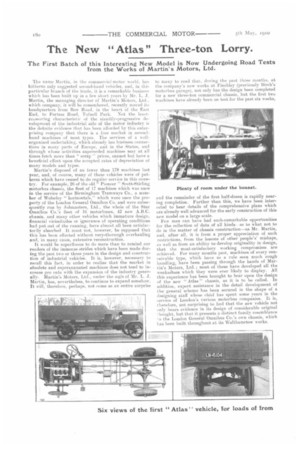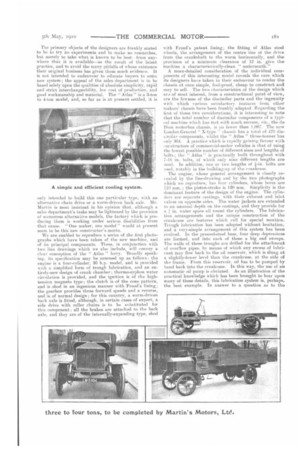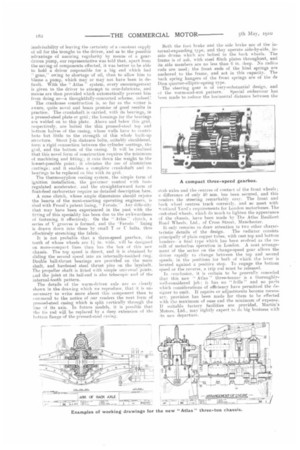The New " Atlas " Three-ton Lorry.
Page 18

Page 19

Page 20

If you've noticed an error in this article please click here to report it so we can fix it.
The First Batch of this Interesting New Model is Now Undergoing Road Tests from the Works of Martin's Motors, Ltd.
The name Martin, in the commercial-motor world. has hitherto only suggested second-hand vehicles, and, in this particular brantili of the trade, it is a remarkable business which has been be up in a few short years by Mr. L. Martin, the managing director of Martin's Motors, Ltd.. which company, it will be remembered, recently moved its headquarters from Bow Road. in the heart of the East End, to Fortess Road, 'Land! Park. Not the leastreassuring characteristic of the steadily-progressive development of the industrial side of the motor industry is the definite evidence thathas been afforded by this enterprising company that there is a free market in secondhand machines of most types. The services of a wellorganized undertaking, which already has business connections in many parts of Europe, and in the States, and through whose activities superseded machines may at all times fetch more than " scrap " prices, cannot but have a beneficial effect upon the accepted rates of depreciation of many models and typos.
Martin's disposed of no fewer than 178 machines last year, and, of course, many of these vehicles were of patterns which have ceased to do regular service in this country. For example, 26 of the old Pioneer " Scott-Stirling motorbus chassis, the fleet of 17 machines which was once in the service of the Birmingham Tramways Co., a number of Wolseley " horizontals," which were once the property of the London General Omnibus Co. and were subsequently run by Jobmasters, Ltd., the whole of the Star Omnibus Co.'s fleet of 16 motorbuses, 42 new A.B.C. chassis, and ninny other vehicles which immature design, financial vicissitudes or ignorance of operating conditions had put out of the running, have almost all been satisfactorily absorbed it must not, however, be supposed that this has been effected without very-thorough overhauling and, in many cases, extensive reconstruction.
It would be superfluous to do more than to remind our readers of the immense strides which have been made during the past two or three years in the design and construction of industrial vehiclai. It is, however, necessary to recall this fact, in order to realize that the market in obsolete and superannuated machines does not tend to increase pro rata with the expansion of the industry generally. Martin's Motors, Ltd., under the aigis of Mr. L. J. Martin, has, nevertheless, to continue to expand somehow. It will, therefore, perhaps, not come as an entire surprise
to many to read that, during the past three months, at the company's new works at Finchley (previously Birch's motorbus garage), not only has the design been completed for a new three-ton commercial chassis, but the first twe machines have already been on test for the past six weeks, and the remainder of the first half-dozen is rapidly nearing completion. Further than this, we have been interested to hear details of the comprehensive plans which are already well advanced for the early construction of this new model on a large scale.
Few men can have had such-remarkable opportunities for the collection of data of all kinds-as to what not to do in the matter of chassis construction—as Mr. Martin, and, after all, it is from a proper appreciation of such restrictions, from the lessons of other people's' mishaps, as well as from an ability to develop originality in design, that the most-satisfactory working compromises are achieved. For many months past, machines of every eonoeivable type, which have as a rule seen much rough handling, have been passing through the hands of Martin's Motors, Ltd.; most of these have developed all the weakn&ses which they were ever likely to display. All this experience has been brought to bear upon the design of the new " Atlas" chassis, as it is to be called. In addition, expert assistance in the detail development of the general scheme has been secured in the shape of a designing staff whose chief has spent some years in the service of London's various motorbus companies. It is, therefore, not surprising to find that the new vehicle not only bears evidence in its design of considerable original -.hought, but that it presents a distinct family resemblance .o the London General Omnibus Co.'s own chassis, which has been built throughout at its Walthamstow works.
The primary objects of the designers are frankly stated to he to try no experiments and to make no researches, but merely to take what is known to be best---from anywhere that it is available—as the result of the latest practice, and to avoid the many pitfalls of whose existence their original business has given them much evidence. It is not intended to endeavour to educate buyers to some new system; the appeal of the sales department is to be based solely upon the qualities of absolute simplicity, rapid and strict interchangeability, low cost of production, and good workmanship and material. The " Atlas "is a 3-ton to 4-ton model, and, so far as is at present settled, it is only intended to build. this one particular type, with an alternative chain drive or a worm-driven back axle. Mr. Martin is most. insistent in his opinion that., although a sales department's tasks may he lightened by the provision of numerous alternative models, the factory which is producing them is working under serious disabilities from that cause. "One maker, one model" would at present seem to be this new constructor's motto.
We are enabled to reproduce a series of the first photographs which have been taken of the new machine, and of its principal components. These, in conjunction with two line drawings which we also include, will convey a. clear conception of the " Atlas " lorry. Broadly speaking, its specification may be summed up as follows : the eneine is a four-eylinder, 30 h.p. model, and is provided with a simplified form of trough lubrication, and an entirely-new design of crank chamber ; thermo-syphon water circulation is provided, and the_ ignition is of the hightension magneto type; the clutch is of the cone pattern, and is shod in an ingenious manner with Frood's
the gearbox provides three forward speeds and a reverse, and is of normal design; for this country, a worm-driven back axle is fitted, although, in certain cases of export, a side drive with roller chains is to be substituted for this component; all the brakes are attached to the hack axle, and. they are of the internally-expanding type, shod with Froed's patent lining; the fitting of Atlas steel wheels, the arrangement of the centre line oi the drive from the crankshaft to the worm horizontally, and the provision of a minimum clearance of 12 in. give the machine a characteristically-clean " underneath."
A more-detailed consideration of the individual components of this interesting model reveals the care which its designers have taken in their endeavour to render the chassis at once simple, fool-proof, cheap to construct and easy to sell. The two characteristics of the design which 711's of most interest, from a constructional point of view, are the fewness of the dissimilar parts and the ingenuity with which various satisfactory features from other makers' chassis have been frankly adapted. Regarding the first of these two considerations, it is interesting to note that the total -number of dissimilar components of a typieiti machine which has met with much success-, viz., the de Dion motorbus chassis, is no fewer than 1,087. The new London-General " X-type " chassis has a total of 470 dissimilar components, whilst the " Atlas " three-tanner has only 304. A practice which is rapidly gaining favour with corstructors of commercial-motor vehicles is that of using the lowest possible number of different sizes and lengths of bolts; the " Atlas" is practically built throughout with 7-16 in. bolts, of which only nine different lengths are used. In addition, one or two lengths of -Fin, bolts are esed, notably in the building-up of the crankcase.
The engine, whose general arrangement is clearly resealed by the line-drawing and by the two photographs which we reproduce, has four cylinders, whose bores are 110 mm.; the piston-stroke, is 130 mm. Simplicity is the dominant feature of the design of the engine. The cylinders are separate castings. with their exhaust and inlet valves on opposite sides. The water jackets are extended to an unusual depth on the castings, and they provide for in. water space all round the cylinders. The lubrication arrangements and the unique construction of the crankcase are features which call for special mention. Trough lubrication has been adopted without hesitation, and a very-simple arrangement of this system has been evolved._ In the pressed-steel base, four deep depressions are formed, and into each of these a big end sweeps. The walls of these troughs are drilled for the attachment of overflow pipes, by means of which any excess of lubricant may flow back to the oil reservoir, which is slung at a slightly-lower level than the crankcase, at the side of the frame. From thus reservoir, oil has to be pumped' by hand back into the crankcase. In this way, the use of an automatic oil pump is obviated. As an illustration of the practical knowledge which has been brought to bear upon many of these details, this lubrication system is, perhaps, the best example. In answer to a question as to the inadvisability of leaving the certainty of a constant suppl,,• of oil for the troughs to the driver, and as to the possible advantage of assuring regularity by means of a geardriven pump, our representative was told that, apart from the saving of components effected, it was better to be able to hold a driver responsible for a big end which had " gone," owing to shortage of oil, than to allow him to blame a pump, which may or may not have been in default. With the " Atlas • system, every encouragement is given to the driver to attempt to over-lubricate, and means are then provided which automatically prevent him from doing so—a thoughtfully-concocted scheme, indeed :
The crankcase construction is, so far as the writer is aware, quite novel and bears promise of good results in practice. The crankshaft is carried, with its bearings, in a pressed-steel plate or grid; the housings for the bearings are welded on to this plate. Above and below this grid, respectively, are bolted the thin pressed-steel top and bottom halves of the casing, whose walls have to contribute but little to the strength of this whole built-up structure. Stout fin distance bolts, suitably shouldered, form a rigid connection between the cylinder seatings, the grid, and the bottom of the casing. It will be realized that this novel form of construction requires the minimum of machining and fitting; it cuts down the weight to the lowest-possible point; it obviates the use of aluminium castings; and it enables a complete crankshaft and its bearings to be replaced en bloc with its grid.
The thermo-syphon cooling system, the simple form of ignition installation, the governor control with footregulated accelerator, and the straightforward form of float-feed carburetter require no detailed description here.
A cone clutch, whose ample dimensions should rejoice the hearts of the most-exacting operating engineers, is shod with Frood's patent lining, Ferodo." Any difficulty that may have been experienced in the past with the fitting of this speciality has been due to the awkwardness of fastening it effectively. On the " Atlas '• clutch, a series of V grooves is formed, and the -Ferodo " lining is drawn down into these by small T or U bolts, thus effectively stretching the fabric.
It is not probable that a three-speed gearbox, the teeth of whose wheels are i, in. wide, will be designed on more-compact lines than has the box of this new chassis. The top speed is direct, and it is obtained by sliding the second speed into an internally-toolhed ring. Double ball-thrust bearings are provided on the main shaft, and hardened steel thrust pins on the layshaft. The propeller shaft is fitted with simple universal joints. and the joint at its tail-end is also telescopic and of the internal-tooth pattern.
The details of the worm-driven axle are so clearly shown in the drawing which we reproduce, that it is unnecessary to write more about this component than to commend to the notice of our readers the neat form of pressed-steel easing which is split vertically through the line of its axis. In future models, it is possible that the tie rod will be replaced by a deep extension of the bottom flange of the pressed-steel casing.
Both the foot brake and the side brake are of the internal-expanding type, and they operate side-by-side, inside drums which are bolted to the back wheels. The frame is of ash, with steel flitch plates throughout, and its side members are no less than 6 in. deep. No radius rods are used; the front ends of the hind springs are anchored to the frame, and act in this capacity. The back spring hangers of the front springs are of the de Dion quarter-elliptic-spring type. The steering gear is of very-substantial design, and
of the worm-and-nut pattern. Special endeavour has been made to reduce the horizontal distance between the stub axles and the centres of contact of the front wheels; a difference of only 40 mm. has been secured, and this renders the steering remarkably easy. The front and back wheel centres track correctly, and so meet with S:.otland Yard's requirements for London motorbuses. 'the east-steel wheels, which do much to lighten the appearance of the chassis, have been made by The Atlas Resilient Road Wheels. Ltd.. of Cross Street, Manchester.
It only remains to draw attention to two other characteristic details of the design. The radiator consists principally of plain copper tubes, with cast top and bottom headers.a final type which has been evolved as the result of motorbus operation in London. A neat arrangement of the sector on the change-speed gear allows the driver rapidly to change between the top and second speeds. in the positions for both of which the lever is located against a positive stop. To engage the bottom speed or the reverse, a trip rod must be released. In conclusion, it is certain to he generally conceded that this new " Atlas " three-tonner is a thoroughlywell-considered job: it has no " frills " and no parts which considerations of efficiency have permitted the designer to omit. If repairs or adjustments become necessary. provision has been made for them to be effected with the maximum of ease and the minimum of expense. If suitable factory facilities are provided, Martin's Motors, Ltd., may rightly expect to do big business with its new departure.


























